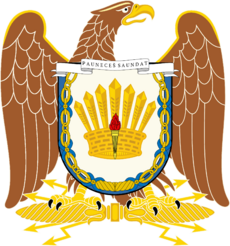Qangreč
Assembly of the Woqalate ᖃᐣᑫᖊᐦ ᕂᐃ ᐓᖃᕋᑌ | |
|---|---|
| 339th Qangreč Ausata'ala | |
 | |
| Type | |
| Type | Unicameral |
| History | |
| Founded | July 31, 677 |
| Preceded by | Abio Senate |
New session started | May 27, 2037 |
| Leadership | |
vacant Since February 17, 2037 | |
vacant Since February 17, 2037 | |
vacant Since February 17, 2037 | |
| Structure | |
 | |
Qangreč political groups |
|
| Elections | |
Qangreč last election | May 17, 2035 |
Qangreč next election | May 17, 2037 |
| Meeting place | |
 | |
The Assembly of the Woqalate (Qabóri: ᖃᐣᑫᖊᐦ ᕂᐃ ᐓᖃᕋᑌ), simply referred to as the Qangreč, the Qabóri translation for the word "assembly," is the supreme legislative body of the Tierradorian Woqalate. It is a unicameral legislature, and is one of few in the world to hold that status. From 1622 to 1971, the Qangreč was bicameral, featuring the Naswadet as the upper house and the Šawardet as the lower. During the height of the Walakee State, however, autocrat Pedro Kintón dissolved both houses and reformed the Qangreč as a 438-member unicameral legislature, as it stands today.
Members of the Qangreč are called delegates, and they typically serve a four-year term. Term limits are in place for every delegate along with the Qaphenć, whom are usually limited to three terms. However, the Fourth Term Rule allows delegates to run for a fourth term, with the risk of no longer being allowed to hold any political office if they lose. Delegates are chosen through 438 single-member constituencies, referred to as ridings. Ridings are redrawn every ten years based on the results of the Tierradorian census.
The powers of the Qangreč are outlined in the Woqalate Charter, which employs a system of checks and balances under semi-balanced jurisdiction of the Crown. Since 1772, all legislative meetings were held in the Tavaleset, one of the main components of the Taisgol Teklan. The qangreč was originally first assembled in 62 AD, as a means for the Qabóri Nation to govern itself during the Abio Woqalate. After the defeat of the Abio Šawardet and Abio Woqalate in the Abio Wars in 677 AD, various assemblies were merged to create the modern Qangreč. From 677 to 1622, the legislature was comprised of 60 independent representatives throughout the Qabóri Woqalate. Following governmental reforms in 1622, the Qangreč was split into two houses with 125 delegates in the Naswadet and 260 delegates in the Šawardet.
Overview
Since 1971, the Qangreč had been a single-branch legislature which consisted of 438 total seats. The Qangreč is elected through a popular vote, with forms of election varying by the respective commonwealth where the election is being held. 12 commonwealths currently use two-round runoff; Auqali, Porvaos, Telohakee, and Teschego use Instant-runoff voting; and Qaleqa and the Saukhin Islands use Party-list proportional representation voting. The 438 seats in the Qangreč are decided by the various constituencies drawn throughout the country, of which they are equally represented by one delegate.
Elections for the Qangreč subsequently become elections for the Qaphenć, as the majority coalition/party's leader is appointed as the Qaphenć by the Woqali. They usually begin with the dissulution of the Qangreč, a power typically held by the Woqali. Tierradorian citizens whom are at least 18 years of age are given the inalienable right to vote in these elections. Until 1971, the two branches of the Qangreč were elected in different ways; by the governors of the commonwealths in the Naswadet, and by popular vote in the Šawardet.
History
Organized legislatures have existed in Tierrador since around 993 BC, with the formation of the Abio Šawardet during the height of the Abio Woqalate. The word šawardet derived from the Ancient Abioic words šazwas and ardet, which means both "speaker" and "assembly," respectively. When combined, the word šawardet means the "Speaker's Assembly." Šawardets were seen commonly throughout major Abioic tribes, formed as an assembly of elders, with the speaker of said assembly being second-in-command to the main leader of the tribe.
The main Šawardet of the Abio Woqalate was not formed until 621 BC, when the tyrant Woqali Kaulí had formed the legislative assembly as a means to project the power she held as the Woqali onto every corner of the Woqalate. All of the tribes would be represented by two delegates, not taking into consideration of the massive gaps in population between the tribes of the time (i.e. Qabóri, Youkafee, and Tauçan compared to several smaller tribes). This would eventually become the status quo throughout the Abio Woqalate until the Qabóri Nation had become frustrated with the lack of consideration to their massive population and influence on the Woqalate. In 62 AD, the Woqalate Charter of the Qabóri Woqalate would be ratified, unofficially establishing the Woqalate and its legislative assembly, the Qangreč.
One other major tribe, Tauçan, would eventually do the same, establishing their own early legislative assemblies. Both the Qabóri and Tauçan nations would use their assemblies to override many policies established by the Imperial House of Youkafee, which was made up of members of the Youkafee Nation. This led to major conflicts between the three tribes, and later many smaller tribes, in what would become the Abio Wars around 261 AD. The wars, which lasted until 677 AD, were led by the Qabóri Woqalate along with several revolutionary tribes against the Abio Woqalate and their hegemony of various tribes.
After the Abio Woqalate was officially defeated, the assemblies of the Qabóri and Tauçan nations merged to form the modern qangreč, with the main legislative council being held in the city of Qabór.